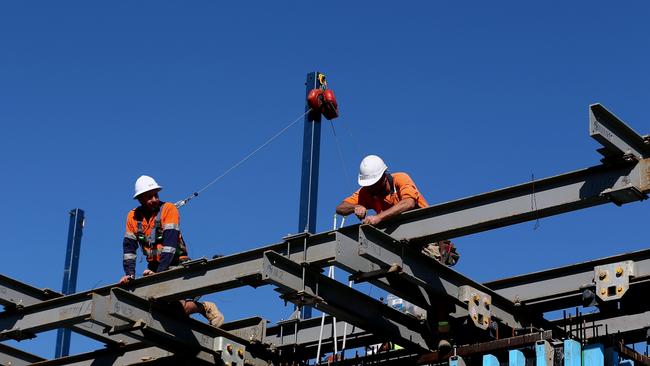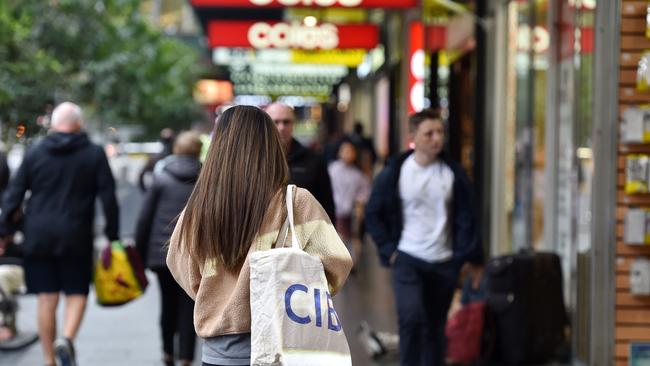Stark reason Australians suddenly feel so poor
You only need to compare two stats to get the grim truth about why Aussies are suddenly feeling the pinch so badly.
Costs
Don't miss out on the headlines from Costs. Followed categories will be added to My News.
Ugh, another bad quarter. Prices went up 1.4 per cent while wages went up 0.8 per cent. We are getting poorer.
Australians are, unfortunately, getting used to that feeling. In fact, we’ve had nearly three years to get used to it, because inflation has been higher than wages growth for almost the past three years.
As the next chart shows, this is unprecedented in recent history. We’ve never even had a year before where inflation was above wages growth.
The previous longest record was three quarters, or nine months (a quarter refers to a three-month period). We’ve certainly outstripped that now, with inflation rising faster than the wage price index for 11 quarters.
The relentless rises in prices and falls in wages means your pay buys less. Money only really has value in terms of what it buys, so even if you got a couple of little pay rises since 2020, you’re probably poorer now in real terms.
I did the maths and the gap between pay and prices over the last three years is worth $4678 for a person earning $70,000 a year, before tax.
That is to say, wages have risen 5.6 per cent since 2020 and prices 12.3 per cent. That 6.7 per cent gap is worth $4678 on a $70,000 salary.
That’s how much the average person on a normal full time wage has gone backwards.

Not everything has gone up in price the same amount, of course. If you are in the middle of a renovation, your costs have probably gone up even more because building homes has got really expensive.
If you eat a lot of dairy, likewise. But if you spend a lot of your pay on clothing and your phone bill, the cost of living effect hasn’t hit you quite so hard. Price rises in those categories have been a bit lower.
Of course, some people are getting ahead despite everything. If you’re in the first half of your career where your pay leaps upwards because you’re getting more skilled, then your personal pay might well have risen more than prices.
(Remember though, the official inflation numbers don’t include mortgage payments and many people in the early part of their career are now having to dig out thousands more each year to pay the bank.)
Also beware, this analysis doesn’t consider any tax cuts. The Stage 1 and Stage 2 tax cuts put more money in people’s pockets over 2018 to 2021. (Although the end of the low and middle income tax offset will make the average person $1500 worse off this year).
But what if you don’t have wages?
Another important point: Not everyone uses wages to buy things. Some use government payments, some use savings, some use assets.
If you have savings making 2 per cent return a year, you’re even worse off than wage-earners. Their buying power is shrinking faster than Alice in Wonderland.

If you had superannuation invested in the stock market, the total return on the top 200 stocks is around 15 per cent since the early 2020 peak, while cumulative inflation is 13.4 per cent. You probably just have your nose in front.
Let’s not even mention the poor sods whose cash was in crypto.
One group that’s got ahead – technically – is those on JobSeeker. That payment is indexed to inflation so they don’t slip behind. It also got a $50 bump from ScoMo and a further $40 bump from Albo.
Don’t get too jealous though – the payment is still well below the poverty line.
Bad news everywhere
No wonder the country is so pessimistic. Consumer confidence is in the loo, as the next chart shows. We were more upbeat in late 2020 when the vaccines weren’t invented, the virus was killing 2 per cent of those infected and lockdowns had us trapped in our own homes.
I can’t help but wonder how long until the pessimism spills over. Other countries riot when prices rise. France had half the country in the streets in 2018 after petrol prices rose and the government then slapped a tax increase on top.
The Romans knew about the importance of panem et circenses: bread and circuses, in keeping the masses happy.
But if the modern circuses is our Netflix subscription, they’ve gone up in price (Standard subscription was $13.99 in 2019, $16.99 now). The price of literal bread is up too.
The unemployment rate rose from 3.5 per cent to 3.7 per cent in April, according to the newest data, and it is expected to keep on rising all the way through to June 2025. I have a bad feeling about how the national mood will look by that point. Early 2025 is also when the next federal election will be, most likely. Australians are unlikely to be in a generous and forgiving mood toward any politician that isn’t taking the cost of living very seriously.
Jason Murphy is an economist | @jasemurphy. He is the author of the book Incentivology.
Originally published as Stark reason Australians suddenly feel so poor





